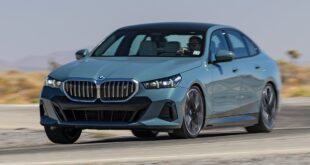Here’s an excerpt of the BMW i8 Review by Complete Car:
The BMW i8 might boast economy and emissions figures that monster even the cleanest, most efficient city cars, but it also delivers the numbers when it comes to performance. The benchmark 100km/h arrives in just 4.4 seconds from rest; it’ll reach 250km/h; and so the combination of its 231hp three-cylinder, turbocharged 1.5-litre petrol engine and 131hp electric motor give it proper sports car performance. It’ll run on electricity alone for up to 35 kilometres, at 120km/h. It’s quick in electric-only mode too, and all but silent – save for a slight, unobtrusive background electrical sound from the motor.
The various drive modes – electric-only, EcoPro hybrid, Comfort hybrid and Sports hybrid – couldn’t be easier to select. Electric-only is achieved by simply pressing a single button, while a toggle switch delivers EcoPro and Comfort, and finally Sport is achieved simply by knocking the automatic transmission selector over to the S position. Switching between these changes the drivetrain characteristics, Comfort being the default, start-up mode, it utilising the plug-in hybrid’s battery element as much as possible for efficiency, the engine only cutting in when you ask for more than the electric motor can provide on its own.
Nothing really surprising among the growing hybrid offerings out there then, save for the dominance of the electric mode around town. The biggest shock comes when selecting Sport. No three-cylinder turbocharged 1.5-litre engine should sound like the i8’s in Sport mode, its deep timbre more muscular big capacity six than blown, small capacity triple. Its 231hp drives the rear wheels, the fronts getting drive from the 131hp electric motor. In Sport mode the brake energy regeneration effect increases, helping allow the drivetrain to always have a power reserve for the battery.
When both motors are working the electric one changes to its second gear, while an additional electric motor, which regenerates on overrun and operates as a starter, also pushes as much as 125Nm of torque into the engine’s crankshaft. That’s done to allow both the front and rear engines work in unison, the additional motor torque filling in the area where the combustion engine would otherwise provide tardy (relatively) response due to its turbocharged nature.
The result is impressive; that the i8 feels largely like a conventionally powered sports car in Sport mode is an achievement. The steering offers fine weighting and its response is immediate. It’s quick, lock is good and feel is decent at lower speeds, though loses a layer of information as the speed rises. Weight distribution is 53% rear, 47% front, while the mass is contained low in the i8’s structure, to the benefit of agility.
The suspension, an adaptive system that firms up in Sports mode, remains supple even in its most focused setting, the i8’s body control over awkward cambers, dips and crests genuinely impressive. You feel its solidity and the stiffness of the carbon structure, yet there’s little harshness through the suspension, the i8 riding with real sophistication. If there’s a shortcoming it’s the i8’s tendency to understeer at higher speeds. At moderate pace it feels neutral, though ask more and the nose begins to push wide. That’s exacerbated by the lack of feel from the brake pedal, which often requires more
 BMW.SG | BMW Singapore Owners Community The Ultimate BMW Community – Established Since 2001
BMW.SG | BMW Singapore Owners Community The Ultimate BMW Community – Established Since 2001














